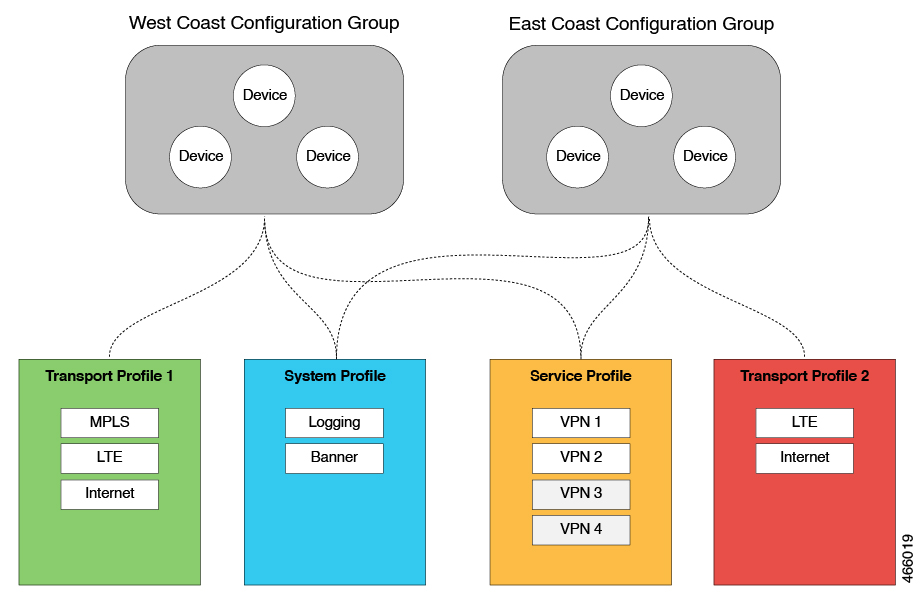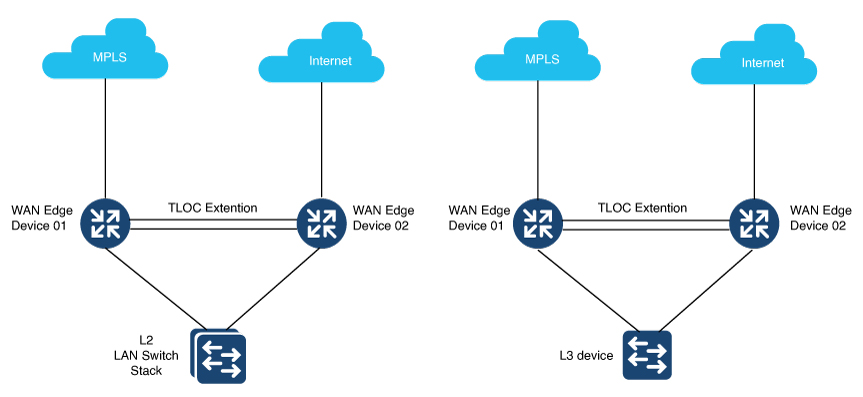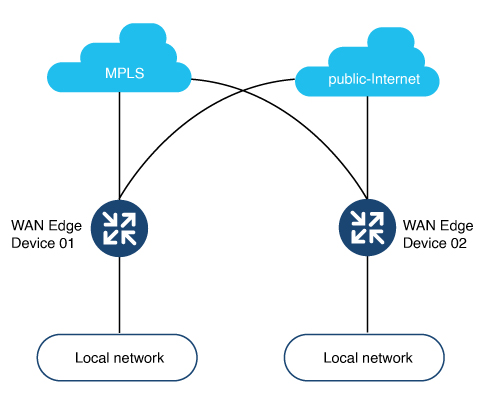Configuration Groups and Feature Profiles
|
Feature Name |
Release Information |
Description |
||
|---|---|---|---|---|
|
Configuration Groups and Feature Profiles |
Cisco IOS XE Catalyst SD-WAN Release 17.8.1a Cisco vManage Release 20.8.1 |
This feature provides a simple, reusable, and structured approach for the configurations in Cisco Catalyst SD-WAN. You can create a configuration group, that is, a logical grouping of features or configurations that is applied to one or more devices in the network that is managed by Cisco Catalyst SD-WAN. You can also create profiles based on features that are required, recommended, or uniquely used, and then combine the profiles to complete a device configuration. The configuration group workflow in Cisco SD-WAN Manager provides a guided method to create configuration groups and feature profiles. |
||
|
Configuration Groups and Feature Profiles (Phase II) |
Cisco IOS XE Catalyst SD-WAN Release 17.9.1a Cisco vManage Release 20.9.1 |
The following enhancements are introduced in the Configuration Group feature.
|
||
|
Create Configuration Group Workflow for a Single-Router Site |
Cisco IOS XE Catalyst SD-WAN Release 17.9.1a Cisco vManage Release 20.9.1 |
This feature introduces the Create Configuration Group workflow. This simplified workflow consolidates the various settings pages into a single page so that you can easily review your configuration at once. The workflow also enables you to set up WAN and LAN routing in addition to the basic settings, at the time of creating a configuration group. As a result, a configuration that is created from the workflow is now immediately deployable. |
||
|
Security Feature Profile in Configuration Groups |
Cisco vManage Release 20.10.1 Cisco IOS XE Catalyst SD-WAN Release 17.10.1a |
This feature enables you to configure a security profile in configuration groups. |
||
|
Localized Policy for QoS, ACL, and Routing |
Cisco vManage Release 20.10.1 Cisco IOS XE Catalyst SD-WAN Release 17.10.1a |
This feature enables you to configure a policy profile, a QoS map policy, a route policy, and an ACL policy through feature profiles. The following enhancements are introduced in this feature:
|
||
|
Variables and Type 6 Encryption in CLI Profile |
Cisco vManage Release 20.10.1 Cisco IOS XE Catalyst SD-WAN Release 17.10.1a |
After you enter or import configuration into a CLI profile, you can convert certain values to device-specific variables or encrypt strings such as passwords, using Type 6 encryption. |
||
|
Cisco Catalyst SD-WAN Remote Access Configuration |
Cisco IOS XE Catalyst SD-WAN Release 17.11.1a Cisco vManage Release 20.11.1 |
This feature enables you to configure Cisco Catalyst SD-WAN Remote Access for a device, using Cisco SD-WAN Manager. Configure Remote Access in the System feature profile in a configuration group.
|
||
|
Device Variables Option |
Cisco IOS XE Catalyst SD-WAN Release 17.11.1a Cisco vManage Release 20.11.1 |
This feature enables you to modify system IP or site ID details of the device from the Associate Devices page while deploying devices. |
||
| Configuration Groups and Feature Profiles (Phase III) |
Cisco IOS XE Catalyst SD-WAN Release 17.11.1a Cisco vManage Release 20.11.1 |
The following new features are introduced to the feature profiles:
|
||
|
Cisco Catalyst SD-WAN Remote Access Configuration in SSL-VPN Mode |
Cisco IOS XE Catalyst SD-WAN Release 17.12.1a Cisco Catalyst SD-WAN Manager Release 20.12.1 |
This feature enables you to configure the following Cisco Catalyst SD-WAN Remote Access features for a device in SSL-VPN mode, using Cisco SD-WAN Manager:
|
||
| Configuration Groups and Feature Profiles (Phase IV) |
Cisco IOS XE Catalyst SD-WAN Release 17.12.1a Cisco Catalyst SD-WAN Control Components Release 20.12.1 |
The following new features are introduced to the feature profiles:
|
||
|
Support for Dual Device Site Configuration |
Cisco IOS XE Catalyst SD-WAN Release 17.12.1a Cisco Catalyst SD-WAN Manager Release 20.12.1 |
This feature supports dual devices site configuration in the configuration groups workflow. You can select the dual router type configuration group workflow to deploy two devices in the same site considering the redundancy in the router. |
||
|
Support for Specifying Default Values for Device-Specific Variables of a Feature |
Cisco IOS XE Catalyst SD-WAN Release 17.15.1a Cisco Catalyst SD-WAN Manager Release 20.15.1 |
You can provide a default value along with description to feature parameters when you select the Device Specific scope. Cisco SD-WAN Manager applies the default value of the parameter to the device while deploying the configuration group. |
||
|
Create a Configuration Group Without Using a Workflow |
Cisco IOS XE Catalyst SD-WAN Release 17.15.1a Cisco Catalyst SD-WAN Manager Release 20.15.1 |
This feature introduces a method for creating configuration groups directly on the Configuration Groups page of Cisco SD-WAN Manager without launching a workflow. After selecting a product solution, you can create a configuration group based on the available profiles for that solution. Cisco SD-WAN Manager creates the configuration group with the required profiles, which you can configure based on your requirement. This feature allows you to reuse previously created profiles. You can create, manage, and deploy the configuration group from one page. |




 Feedback
Feedback